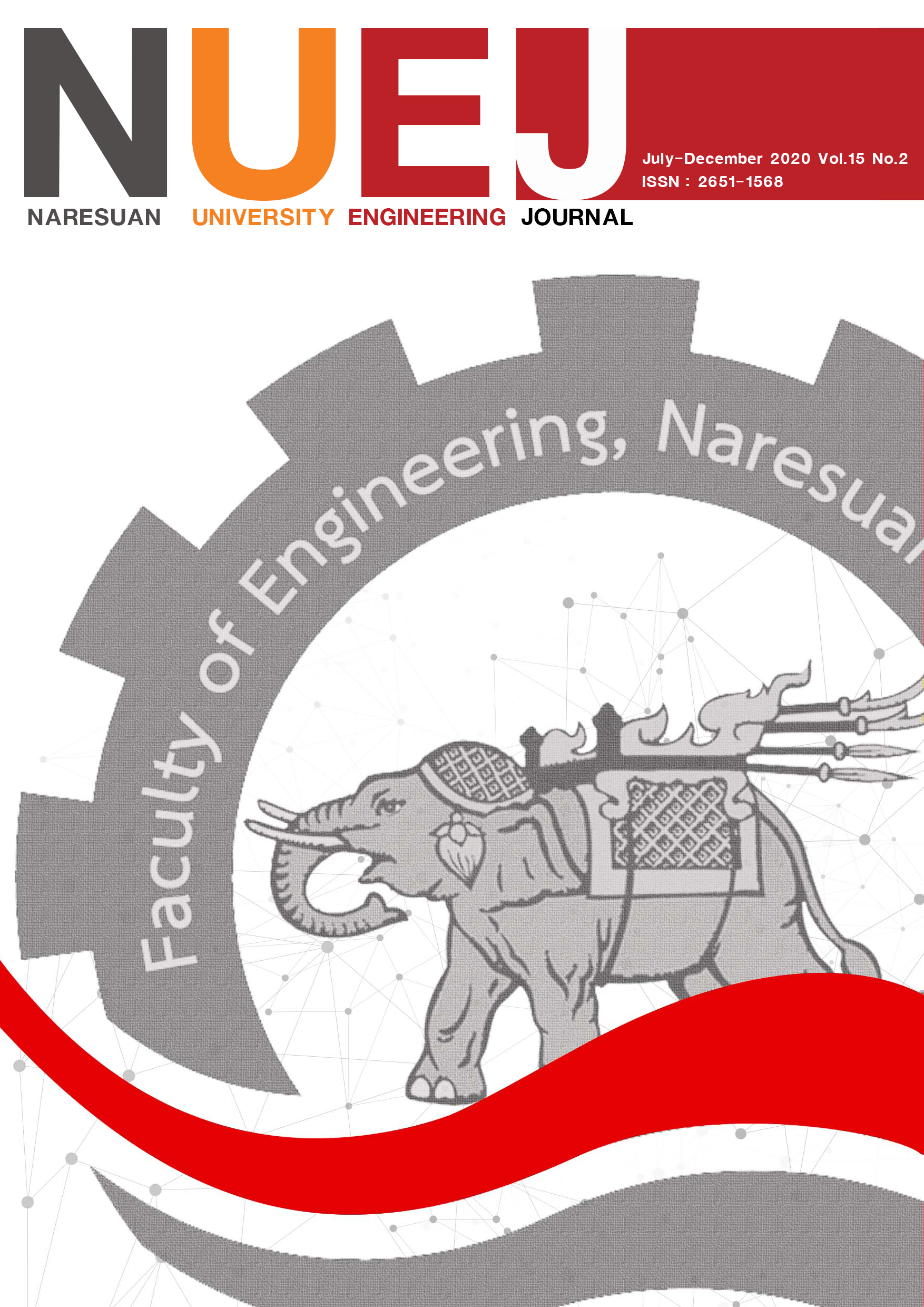OpenFOAM A Numerical Study of Static Performance of Savonius Wind Turbine with Curved Guide Vanes Using OpenFOAM
Main Article Content
Abstract
This paper studies the flow over Savonius wind turbine at the angle of turbine blade of 0°, 30°, 60°, 90°, 120° and 150°. The study was using the commercial Computational Fluid Dynamics (CFD) program, OpenFOAM, and conducted in a 2D domain. The numerical and experimental results were compared for validation at the Reynolds number of 4.32× 105. The propose is to numerically simulate the behavior of airflow though turbine blade including pressure contour and velocity streamline. Moreover, the present study is to show the effect of the Savonius wind turbine with curved guide vanes on the performance. The results show that the turbine with the curved guide vanes has a higher torque coefficient compared to conventional rotors at the 0°, 30°, 60°, 120° and 150° positions except 90°. Those obtained results will be used as parameters to design for improvement the performance of Savonius wind turbine.
Article Details
References
Altan, B. D., & Atilgan, M. (2010). The use of a curtain design to increase the performance level of a Savonius wind rotors. Renewable Energy, 35, 821-829.
Altan, B. D., Atilgan, M., & Ozdamar, A. (2008). An experimental study on improvement of a Savonius rotor performance with curtaining. Experimental Thermal and Fluid Science 32, 1673-1678.
Anderson, J. D. (1995). Computational Fluid Dynamics: The basics with applications. McGrawHill Book.
Blackwell, B. F., Sheldahl, R. E., & Feltz, L. V. (1977). Wind tunnel performance data for two- and three-bucket Savonius rotors. Sandia Report SAND 76-0131.
Chaiworapuek, W., & Saengswarng, S. (2015). Prediction of Static Performance of Savonius Wind Turbine under the Variation of Wind Velocities. Kasetsart engineering journal, 94(28), 1-10.
Chong, W. T., Poh, S. C., Fazlizan, A., & Pan, K.C. (2012). Vertical axis wind turbine with omni-directional guide vane for urban high-rise buildings. Journal of Central South University, 19, 727-732.
Hayashi, T., Li, Y., & Hara, Y. (2005). Wind tunnel tests on a different phase three-stage Savonius rotor. JSME International Journal Series B Fluids and Thermal Engineering, 48(1), 9-16.
Kacprzak, K., Liskiewicz, G., & Sobczak, K. (2013). Numerical investigation of conventional and modified Savonius wind turbines. Renewable Energy, 60, 578 – 585.
Launder, B. E., & Spalding, D. B. (1972). Lectures in Mathematical models of turbulence. Academic Press.
Loksupapuiboon, K., & Suvanjumrat, C. (2020). Validation of Wall Functions for Two-Equation Turbulence Models of OpenFOAM. The Engineering Institute of Thailand under H.M. The King’s Patronage, 31(2), 105-117.
Menet, J. L., & Rezende, T. D. (2013). Static and dynamic study of a conventional Savonius rotor using a numerical simulation [Paper presentation]. 21è Congrès FranÇais de Mécanique (CFM), Bordeaux, France.
Menter, F. R. (1993). Zonal two equations k- ω turbulence models for aerodynamic flows. AIAA-93-2906.
Mohamed, M. H. (2011). Design optimization of Savonius and wells turbines [Doctoral dissertation]. Otto von Guericke University of Magdeburg. https://d-nb.info/1011710889/34
Mohamed, M. H., Janiga, G., Pap, E., & Thevenin, D. (2011). Optimal blade shape of a modified Savonius turbine using an obstacle shielding the returning blade. Energy Conversion and Management, 52, 236 - 242.
OpenCFD. (2011, August 8). OpenFOAM foundation. http://www.openfoam.com
Roy, S., & Saha, U. K. (2013) Review on the numerical investigations into the design and development of Savonius wind rotors. Renewable Sustainable Energy Rev, 24(2013), 73-83.
Shaheen, M., El-Sayed, M., & Abdallah, S. (2015). Numerical study of two-bucket Savonius wind turbine cluster. Journal of Wind Engineering and Industrial Aerodynamics, 137, 78-89.
Suvanjumrat, C. (2017). Comparison of Turbulence Models for Flow Past NACA0015 Airfoil using OpenFOAM. Engineering Journal, 21(3), 207-221.
Suvanjumrat, C. (2018). Computational Fluid Dynamics of finite volume method. Mahidol University Press.
The Renewable Energy Website (2017, September 9). Savonius Wind Turbines. http://www.reuk.co.uk
Versteeg, H. K., & Malalasekera, W. (2007). Implementation of boundary conditions, An Introduction to Computational Fluid Dynamics: The Finite Volume Method (2nd ed.). Pearson Education Limited.
Versteeg, H. K., & Malalasekera, W. (1995). Introduction to Computational Fluid Dynamics: The Finite Volume Method. John Wiley and Sons.
Wang, H., Wang, J., Yao, J., Yuan, W., & Cao, L. (2012). Analysis on the aerodynamic performance of vertical axis wind turbine subjected to the change of wind velocity. Procedia Engineering, 31, 213-219.
Watson, D. (2017, September 8). Wind Turbines and the Energy in Wind. http://www.ftexploring.com
Wilcox, D. C. (1994). Turbulence energy equation models, in Turbulence Modelling for CFD (2nd ed.). ECW Industries.


